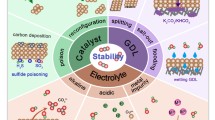Abstract
The adsorption processes of elemental lead on carbonaceous surfaces which adsorbed CO/CO2/NO flue gases were investigated to understand the effects of CO/CO2/NO on elemental lead adsorption on carbonaceous surfaces with density functional theory. All calculations including optimizations, energies, and frequencies were conducted at B3PW91 density functional theory level, utilizing SDD basis set for lead and 6-31G(d) Pople basis set for other atoms. The results indicate that CO, CO2, and NO can promote the adsorption of elemental lead on the carbonaceous surface, but probably compete for adsorption sites with elemental lead. The promotion effects on adsorption can be attributed to active sites on the carbonaceous surface rather than flue gas adsorption on the carbonaceous surface. In addition, the adsorption order of three kinds of flue gas on the carbonaceous surface is CO2 > NO > CO > Pb on average. Furthermore, the enhancement order of three kinds of flue gas on the elemental lead adsorption on carbonaceous surfaces is CO-CS > CO2-CS > NO-CS > CS in general. In particular, atomic charge and adsorption energy have good linear relationship in the process of elemental lead adsorption.

Competitive adsorption between flue gas and elemental lead on carbonaceous surfaces.









Similar content being viewed by others
References
Iyer S, Sengupta C, Velumani A (2015) Lead toxicity: an overview of prevalence in Indians. Clinica Chimica Acta
Debelius B, Forja JM, DelValls Á et al. (2009) Toxicity and bioaccumulation of copper and lead in five marine microalgae. Ecotoxicol Environ Saf 72(5):1503–1513
Lee YH, Lee DH, Kim JH et al (1995) Blood lead levels in children. Korean J Occup Environ Med 7(1):82–87
Hildebrand MP (2011) Lead toxicity in a newborn. J Pediatr Health Care 25(5):328–331
Shen ZG, Li XD, Chen HM et al (2002) Phytoextraction of Pb from a contaminated soil using high biomass species of plants. J Environ Qual 31:1893–1900
Nriagu JO (1989) A global assessment of natural sources of atmospheric trace metals. Nature 338(6210):47–49
Li XL, Zhang YX, Tan MG et al (2009) Atmospheric lead pollution in fine particulate matter in Shanghai, China. J Environ Sci 21(8):1118–1124
Tan MG, Zhang GL, Li XL et al (2006) Comprehensive study of lead pollution in Shanghai by multiple techniques. Anal Chem 78(23):8044–8050
Lou MT, Qin JF, Li ZX et al (2012) Review on lead pollution in China. Guangdong Trace Elem Sci 19(10):10–20
Qin JF, Li ZX, Lou MT et al (2010) Status sources of pollution and control measures of Chinese children lead poisoning. Guangdong Trace Elem Sci 17(1):1–13
Deng S, Zhang F, Liu Y et al (2013) Lead emission and speciation of coal-fired power plants in China. China Environ Sci 33(7):1199–1206
Chen SJ, Xue JM, Xu YY et al (2015) Analysis on reduction of trace elements in flue gas by dust removing facilities in coal-fired power plants. Proc CSEE 35(9):2224–2230
Li J, Maroto-Valer MM (2012) Computational and experimental studies of mercury adsorption on unburned carbon present in fly ash. Carbon 50(5):1913–1924
Padak B, Brunetti M, Lewis A et al (2006) Mercury binding on carbonaceous. Environ Prog 25(4):319–326
Matsumura Y (1974) Adsorption of mercury vapor on the surface of activated carbons modified by oxidation or iodization. Atmos Environ (1967) 8(12):1321–1327
Hu C, Zhou J, He S et al (2009) Effect of chemical activation of an activated carbon using zinc chloride on elemental mercury adsorption. Fuel Process Technol 90(6):812–817
Zhang Y, Zhao L, Guo R et al (2015) Mercury adsorption characteristics of HBr-modified fly ash in an entrained-flow reactor. J Environ Sci 33:156–162
Mei Z, Shen Z, Zhao Q et al (2008) Removal and recovery of gas-phase element mercury by metal oxide-loaded activated carbon. J Hazard Mater 152(2):721–729
Zhou Q, Duan YF, Hong YG et al (2015) Experimental and kinetic studies of gas-phase mercury adsorption by raw and bromine modified activated carbon. Fuel Process Technol 134:325–332
Padak B, Wilcox J (2009) Understanding mercury binding on activated carbon. Carbon 47(12):2855–2864
Montoya A, Truong TTT, Mondragon F et al (2001) CO desorption from oxygen species on carbonaceous surface: 1. Effects of the local structure of the active site and the surface coverage. J Phys Chem A 105(27):6757–6764
Montoya A, Mondragon F, Truong TN (2002) First-principles kinetics of CO desorption from oxygen species on carbonaceous surface. J Phys Chem A 106(16):4236–4239
Wu X, Radovic LR (2004) Ab initio molecular orbital study on the electronic structures and reactivity of boron-substituted carbon. J Phys Chem A 108(42):9180–9187
Radovic LR (2005) The mechanism of CO 2 chemisorption on zigzag carbon active sites: a computational chemistry study. Carbon 43(5):907–915
Chen N, Yang RT (1998) Ab initio molecular orbital study of the unified mechanism and pathways for gas-carbon reactions. J Phys Chem A 102(31):6348–6356
Chen N, Yang RT (1998) Ab initio molecular orbital calculation on graphite: Selection of molecular system and model chemistry. Carbon 36(7):1061–1070
Liu J, Cheney MA, Wu F et al (2011) Effects of chemical functional groups on elemental mercury adsorption on carbonaceous surfaces. J Hazard Mater 186(1):108–113
Liu J, Qu W, Yuan J et al (2009) Theoretical studies of properties and reactions involving mercury species present in combustion flue gases. Energy Fuel 24(1):117–122
Liu J, Qu W, Joo SW et al (2012) Effect of SO2 on mercury binding on carbonaceous surfaces. Chem Eng J 184:163–167
Frisch MJ, Trucks GW, Schlegel HB, Scuseria GE, Robb MA, Cheeseman JR et al (2010) Gaussian09, revision B.01. Gaussian Inc, Wallingford
Xin G, Zhao P, Zheng C (2009) Theoretical study of different speciation of mercury adsorption on CaO (001) surface. Proc Combust Inst 32(2):2693–2699
Author information
Authors and Affiliations
Corresponding author
Rights and permissions
About this article
Cite this article
Gao, Z., Yang, W. Effects of CO/CO2/NO on elemental lead adsorption on carbonaceous surfaces. J Mol Model 22, 166 (2016). https://doi.org/10.1007/s00894-016-3023-z
Received:
Accepted:
Published:
DOI: https://doi.org/10.1007/s00894-016-3023-z




